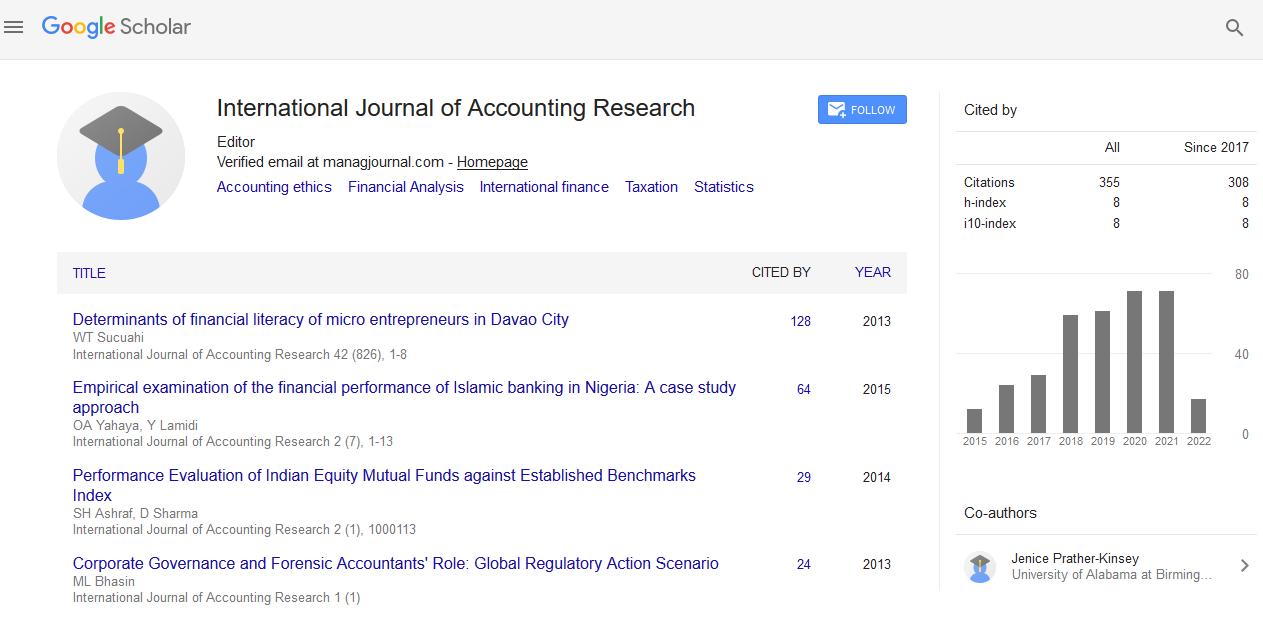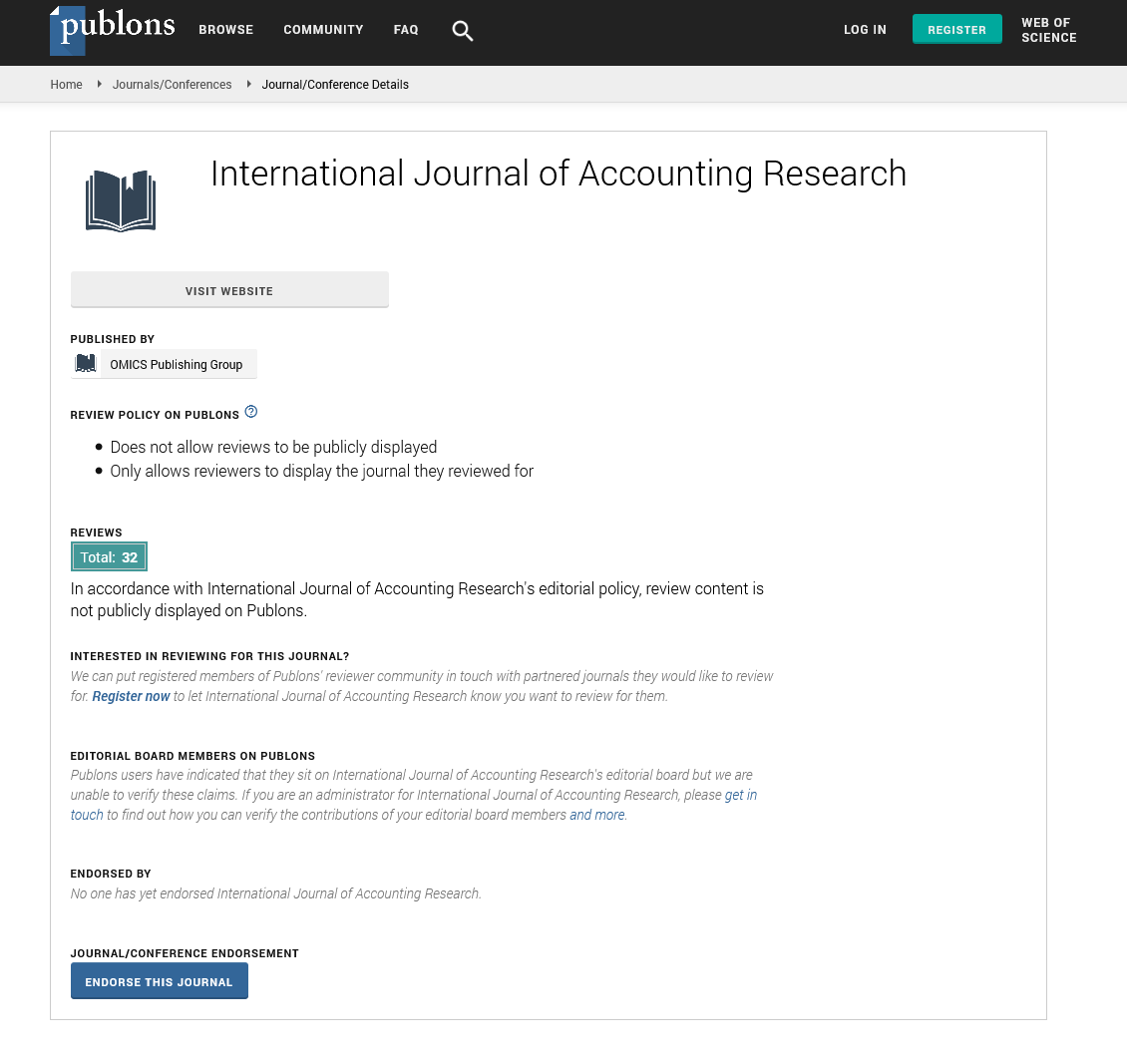Indexed In
- Open J Gate
- RefSeek
- Hamdard University
- EBSCO A-Z
- Scholarsteer
- Publons
- Euro Pub
- Google Scholar
Useful Links
Share This Page
Journal Flyer

Open Access Journals
- Agri and Aquaculture
- Biochemistry
- Bioinformatics & Systems Biology
- Business & Management
- Chemistry
- Clinical Sciences
- Engineering
- Food & Nutrition
- General Science
- Genetics & Molecular Biology
- Immunology & Microbiology
- Medical Sciences
- Neuroscience & Psychology
- Nursing & Health Care
- Pharmaceutical Sciences
Opinion Article - (2024) Volume 12, Issue 3
Transforming Corporate Governance: Enhancing Accountability and Transparency
John Karim*Received: 30-Aug-2024, Manuscript No. IJAR-24-27286; Editor assigned: 02-Sep-2024, Pre QC No. IJAR-24-27286 (PQ); Reviewed: 16-Sep-2024, QC No. IJAR-24-27286; Revised: 23-Sep-2024, Manuscript No. IJAR-24-27286 (R); Published: 30-Sep-2024, DOI: 10.35248/2472-114X.24.12.388
Description
Transforming corporate governance with data analytics represents a significant evolution in how organizations manage accountability and transparency. As businesses increasingly depend on data-driven decision-making, integrating data analytics into corporate governance frameworks can lead to enhanced oversight, improved risk management and greater transparency. This shift from traditional governance practices to data-driven approaches is reshaping the landscape of corporate accountability, providing new tools and methodologies to address complex governance challenges.
Data analytics involves the systematic use of data, statistical algorithms and machine learning techniques to uncover understanding and inform decision-making. In the context of corporate governance, data analytics can be used to analyze vast amounts of data from various sources, such as financial records, operational metrics, compliance reports and employee feedback. By utilizing these insights, organizations can enhance their governance practices, identify potential risks and improve overall performance.
One of the primary ways data analytics transforms corporate governance is by enhancing transparency. Traditionally, transparency in corporate governance was achieved through regular financial disclosures, board meetings and compliance reports. However, these methods often provide a limited view of an organization's operations and can be susceptible to information asymmetry. Data analytics offers a more comprehensive approach by providing real-time insights into Key Performance Indicators (KPIs), operational metrics and risk factors. Through dashboards, visualizations and interactive reports, stakeholders can access detailed and timely information, leading to improved understanding and scrutiny of corporate activities.
Data analytics also plays a key role in enhancing accountability within organizations. Accountability involves ensuring that individuals and teams are responsible for their actions and decisions and that these are aligned with the organization's goals and policies. Analytics can help in monitoring and evaluating performance by tracking progress against established benchmarks, identifying deviations and assessing the effectiveness of governance practices. For instance, data analytics can be used to analyze executive compensation in relation to company performance, ensuring that remuneration practices are aligned with shareholder interests and organizational objectives.
In addition to monitoring performance, data analytics can also improve risk management by providing early warning signals and predictive insights. Traditional risk management practices often rely on historical data and subjective assessments, which may not fully capture emerging risks or trends. Data analytics enables organizations to analyze large datasets, identify patterns and forecast potential risks. For example, predictive analytics can be used to assess the likelihood of financial fraud by analyzing transaction data for unusual patterns or anomalies. By proactively identifying and addressing risks, organizations can mitigate potential issues before they escalate, enhancing overall governance effectiveness.
Furthermore, data analytics can support more informed decision making by providing evidence-based insights and reducing reliance on intuition or anecdotal information. Corporate governance involves making strategic decisions that impact the organization's direction and performance. By utilizing data analytics, boards and executives can make decisions based on empirical evidence, trends and patterns, rather than solely on historical precedents or subjective opinions. This data-driven approach can lead to more rational and objective decisionmaking, ultimately benefiting the organization and its stakeholders.
The integration of data analytics into corporate governance also promotes a culture of continuous improvement. By regularly analyzing and reviewing data, organizations can identify areas for enhancement and implement data-driven strategies for improvement. For example, data analytics can be used to evaluate the effectiveness of compliance programs, assess employee engagement levels and monitor stakeholder feedback. This iterative approach allows organizations to adapt and refine their governance practices, ensuring they remain effective and responsive to changing conditions.
One of the key challenges is ensuring data quality and accuracy. Data-driven insights are only as reliable as the data they are based on and inaccurate or incomplete data can lead to flawed conclusions and decisions. Organizations must invest in data management practices, including data governance, validation and security, to ensure the integrity and reliability of their data.
Citation: Karim J (2024). Transforming Corporate Governance: Enhancing Accountability and Transparency. Int J Account Res. 12:388.
Copyright: © 2024 Karim J. This is an open access article distributed under the terms of the Creative Commons Attribution License, which permits unrestricted use, distribution, and reproduction in any medium, provided the original author and source are credited.


